
The Kentucky Distillers’ Association – KDA has been the leading voice to promote, protect and elevate Kentucky’s signature bourbon and distilled spirits industry for nearly a century and a half. Since its founding in 1880 the non-profit organization has been working with local, state, and federal governments to keep the amber spirit flowing. And this week was no different as distillers and lawmakers joined together at the State Capital in Frankfort to share and celebrate the findings of the 2024 edition of the biennial ‘Bourbon Economic Impact Report’.
It is often said ‘if you can’t measure it, you can’t manage it.’ The KDA is living proof of those words as they have been consistently reporting on the state of the bourbon industry since 2008. The Association connected with Dr. Paul Coomes Emeritus Professor of Economics at University of Louisville, and they’ve been gathering and sharing distilled spirits industry data ever since.
Topline results of this year’s research show that Kentucky Bourbon now provides more jobs, generates more payroll, pays more taxes, attracts more tourists, and features more distilleries than ever before.
“Kentucky bourbon, according to this latest study, is now a $9 billion economic and tourism powerhouse,” said Kentucky Distillers’ Association President Eric Gregory. “We are creating over 23,100 good paying jobs, that carry about $1.63 billion in payroll, we are in the middle of a $5.3 billion in capital investment, and we are returning about $358 million in tax revenue to the Commonwealth every year.”
Kentucky Distillers’ Association President Eric Gregory.
Subscribe to DistilleryTrail’s YouTube channel.
Heaven Hill Distillery General Counsel & Chief Compliance Officer and 2024 Chair of the Board of the Kentucky Distillers’ Association Jes Penergrass.
“Bourbon is the economic backbone of Kentucky,” according to General Counsel & Chief Compliance Officer of Heaven Hill Distillery Jes Penergrass. “When you hear a number like $9 billion economic impact, 23,000 jobs, $1.63 billion in salaries and wages, that is an unbelievable number. And you add that 2 million tourists coming to the Kentucky Bourbon Trail every year really its just a foundation of who Kentucky is.” Pendergrass is also the 2024 Chair of the Kentucky Distillers’ Association.
“Traditionally, Bourbon is known as a manufacturing powerhouse, but its influence really extends beyond production, as we continue to foster and grow partnerships with our local communities,”
The report used data from 100 distilleries in 42 counties and found that the industry continues to grow local communities with jobs, tax revenue, agriculture, tourism, and out-of-state spending.
“While the Bourbon report includes a deep analysis of industry metrics, forecasts, and of course, accolades from enthusiasts, our KDA members, deeply rooted in the Commonwealth, are proud to share the compelling story of how “Bourbon Builds Kentucky,” added Pendergrass.
Kentucky Bourbon’s $9 Billion Economic Impact
The 2024 report estimates the total annual economic impact of the distilling industry is 23,100 jobs, with annual wages and salaries of $1.63 billion, producing $9 billion of economic output. These are reasonable estimates of what would happen in the state in the event the distilling industry disappeared from Kentucky (gasp).

-
Save
When it comes to the Bourbon economy taxes, the report found that Kentuckians are receiving $358 million in state and local taxes every year from distillers.
And, even though it remains the highest taxed large manufacturing industry in KY at $.17 per dollar, no other industry in the state has higher shares of national employment (27%), labor compensation (26%) and output than distilling. Kentucky distillers shipped more than $500 million in exports in 2022, almost all of which was Bourbon.
“Not only is Bourbon building Kentucky communities, but it’s also elevating Kentucky’s stature internationally as exports grow and distillers across the globe look to Kentucky for how to do it right,” said Pendergrass.
“Kentucky’s economy is booming, and the bourbon industry is helping us build a strong economy for generations to come,” said Kentucky Gov. Andy Beshear. “Today, this signature industry is generating $9 billion in total economic impact, with more on the way. We thank our distilleries for working hard to create more good jobs and boosting our tourism industry across the Commonwealth.”
Stay Informed: Sign up here for the Distillery Trail free email newsletter and be the first to get all the latest news, trends, job listings and events in your inbox.
Distilleries Have Expanded Beyond the “Amber Triangle’ to All Parts of Kentucky
The report found that the popularity of Bourbon has spawned distilling operations to all regions of the state, in contrast to the geographic centralization of the 20th century which concentrated in the area between Louisville, Bardstown and Lexington and coined the “Amber Triangle.” This century also brought the emergence of “Urban Bourbon,” with distilleries and tasting rooms in downtowns, as well as Bourbon-themed hotels, B&Bs, Air B&Bs and short-term housing rentals.
The first report from 2008 identified 19 distilling establishments in eight counties, directly supporting about 3,000 jobs. The latest 2024 report shows there are now 100 distilling establishments in 42 counties directly employing approximately 7,000 people.
Item | 2009 | 2022 |
|---|---|---|
# Distilleries | 19 | 100
(A 5x Increase) |
# Counties | 8 | 42
(Out of 129 or 35%) |
# Direct Jobs | 3,000 | 7,000 |
Economic Impact Jobs | 9,848 | 23,100 |
Economic Impact on Payroll | $442 Million | $1.63 Billion
(More than double over 14 years.) |
How Many Barrels of Bourbon & Spirits are Aging in Kentucky?
Bourbon production and the number of barrels of bourbon and other spirits aging in Kentucky has set a record.
Take a drive around Kentucky and it is not uncommon to see cranes lifting huge parts of rickhouses into place to build new barrel warehouses. Afterall, all that bourbon must go somewhere.
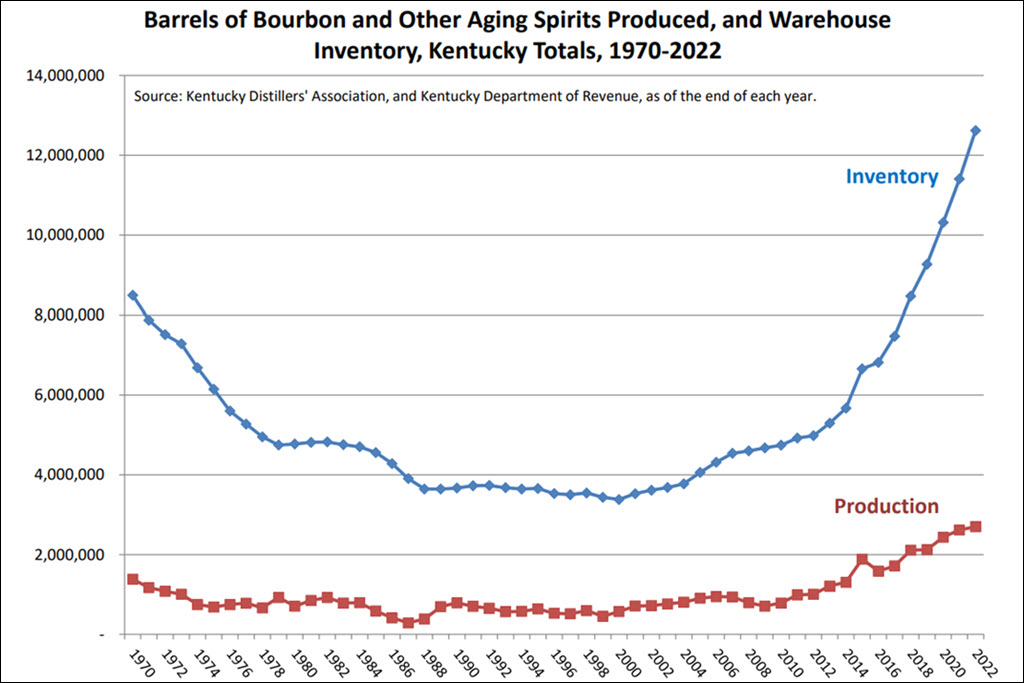
-
Save
Barrels of Bourbon & Other Spirits Production & Warehouse Inventory 1970 to 2022.
Annual bourbon production last year was almost four times what it was 20 years ago. Kentucky distillers produced 2.7 million barrels of Bourbon in 2022, and now have a record 12.6 million Bourbon barrels stored in warehouses. Counting other spirits such as Brandy, there are 13.3 million barrels of spirits aging in Kentucky. Bourbon dominates the aging spirits category, which also includes about 100,000 barrels of light whiskey and single malt whiskey.
The value of all inventory in bonded warehouses (which includes bulk inventory and cases being held for shipment as well as distilled spirits in barrels) was assessed for state tax purposes at a record $6.7 billion for the 2023 tax year – based on end of 2022 number of barrels, and the increased valuation per barrel. Inventory subject to county-level property taxes (mostly in barrels) was assessed at $2.9 billion for tax year 2023. See the full report for the fiscal impact section for the differences between state and local tax bases.
How Much Money are Kentucky Distillers Investing Now and Over the Next Few Years?
The report looks at capital expenditures over the last five years and projections for the next five years. As you can see, things are not slowing down anytime soon.
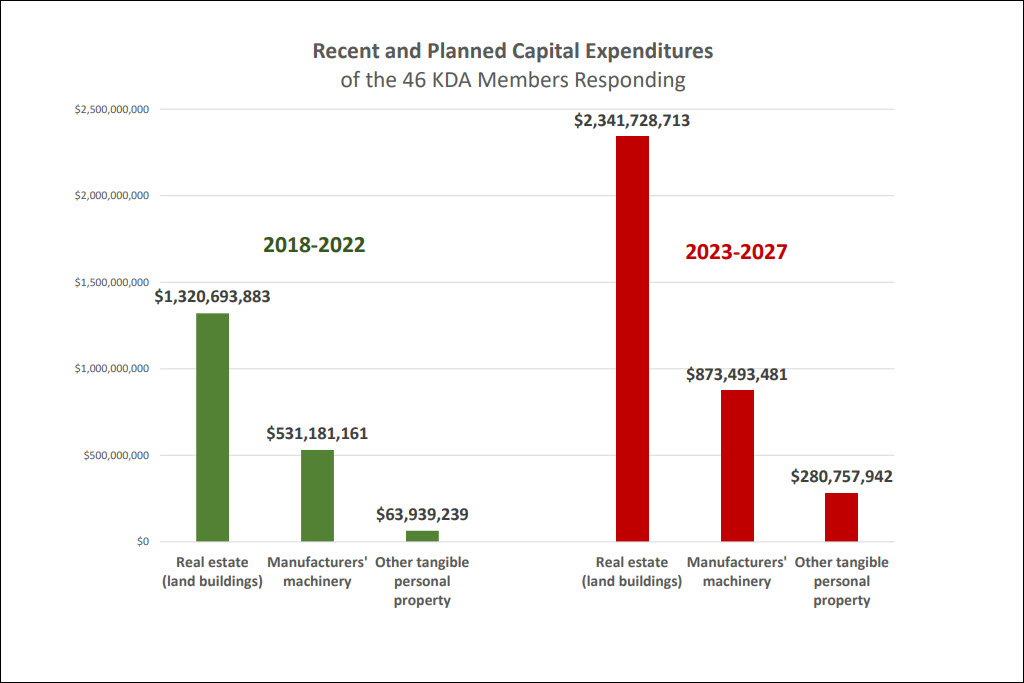
-
Save
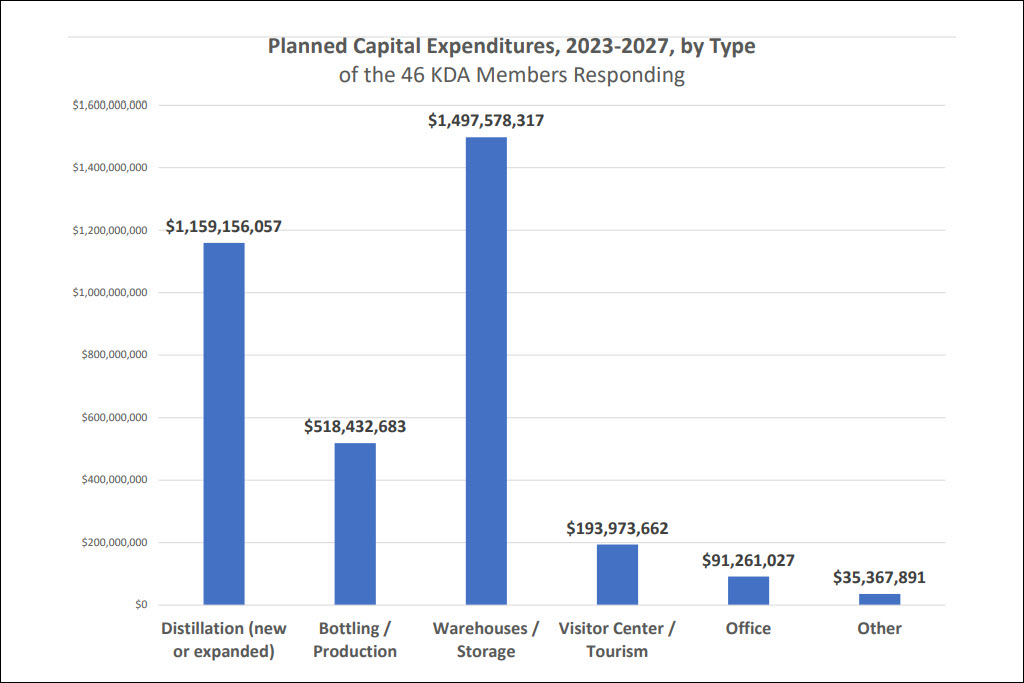
-
Save
KDA members reported capital spending of $1.9 billion over the last five years, almost equally split between construction and other items, such as machinery, equipment, and furnishings. Moreover, they plan to spend $3.5 billion over the next five years for a total of $5.4 billion in capital investment over the 10-year period. Every KDA member, whether a large Heritage producer or a small Craft distiller, reported significant investments. This reflects a steady continuation of billions in investment spending we have documented over our previous studies.
Note: Not all Kentucky distilleries are KDA members, so the actual capital expenditures are higher. You could even say ‘much’ higher when you consider Buffalo Trace Distillery in Frankfort is not included in these expenditure numbers.
Bourbon is an Agricultural Product that Requires Lots of Grain

-
Save
There is a relatively fixed ratio of grain required to produce, say, a barrel of Bourbon. Hence, we know from production records and the 2023 survey of KDA members that Kentucky distillers purchased about 28.3 million bushels of corn and around 13.2 million bushels of other grains such as wheat and rye.
Survey respondents reported that 70 percent of corn used was purchased from Kentucky farms, up from 40 percent in our first grain survey in 2014. Only 19 percent of other grains used came from Kentucky. Applying these survey results to total industry production, we estimate that Kentucky distillers purchased 19 million bushels of corn, and 2.6 million bushels of other grains, from Kentucky farmers. Thus, Kentucky distillers purchased about nine percent of the total of 210.6 million bushels of corn produced in Kentucky in 2022. This correlated growth was especially apparent in Nelson, Shelby, Washington, Mercer and Marion counties – where large, heritage distillers are located. Nelson County is, of course, home to many heritage distilleries. Marion County is home to Maker’s Mark Distillery has seen a tripling of corn production over the past 20 years.
Additionally, some Kentucky distillery companies purchased significant amounts of Kentucky corn for operations in other states.
Grains | Total Bushels | Kentucky Grown Bushels |
|---|---|---|
Corn | 28.3 Million | 19 Million (67%) |
Wheat/Rye/Other | 13.2 Million | 2.6 Million (19.7%) |
“Kentucky agriculture and farmers have seen the impact of the Bourbon industry boom firsthand,” said Commissioner Shell. “Kentucky farmers sold nearly 19 million bushels of corn and 2.6 million bushels of other grains to Kentucky distillers last year. The economic effects on our industry are building a stronger agricultural community for years to come.”
Kentucky Distillers Pay 24% of All Alcohol Excise Taxes in the U.S.
According to the U.S. Alcohol and Tobacco Tax and Trade Bureau – TTB, Kentucky is responsible for 24% of all federal alcohol excise tax collections, up two percentage points since 2020.
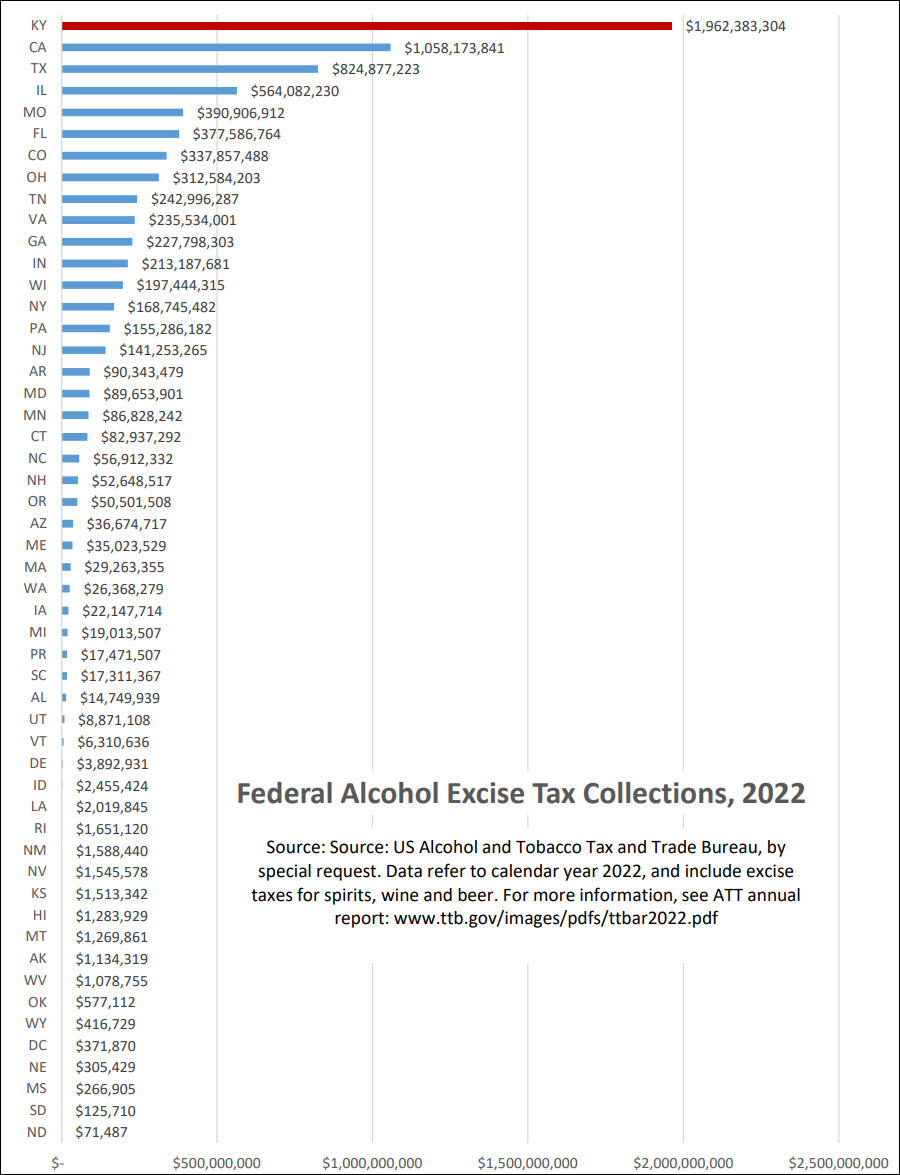
-
Save
Check the full report for additional tax information like,
- Production and consumption
- Property taxes
- Tangible property taxes
- Inventory taxes
- Payroll taxes
- Consumption taxes
Exports Account for More Than Half a Billion Dollars
Exports are an important part of Kentucky Bourbon’s success. Kentucky distillers shipped over $508 million of spirits products abroad in 2022, with whiskey accounting for 80 percent of the total and Bourbon the main component. Whiskey exports have recovered from the tariff-induced decline in 2020 that reduced Kentucky exports by $170 million. Other products exported by Kentucky distillers include Brandy, liqueurs, cordials, vodka, rum and gin.
Here is a look at the top 30 countries for Kentucky spirits in 2022.
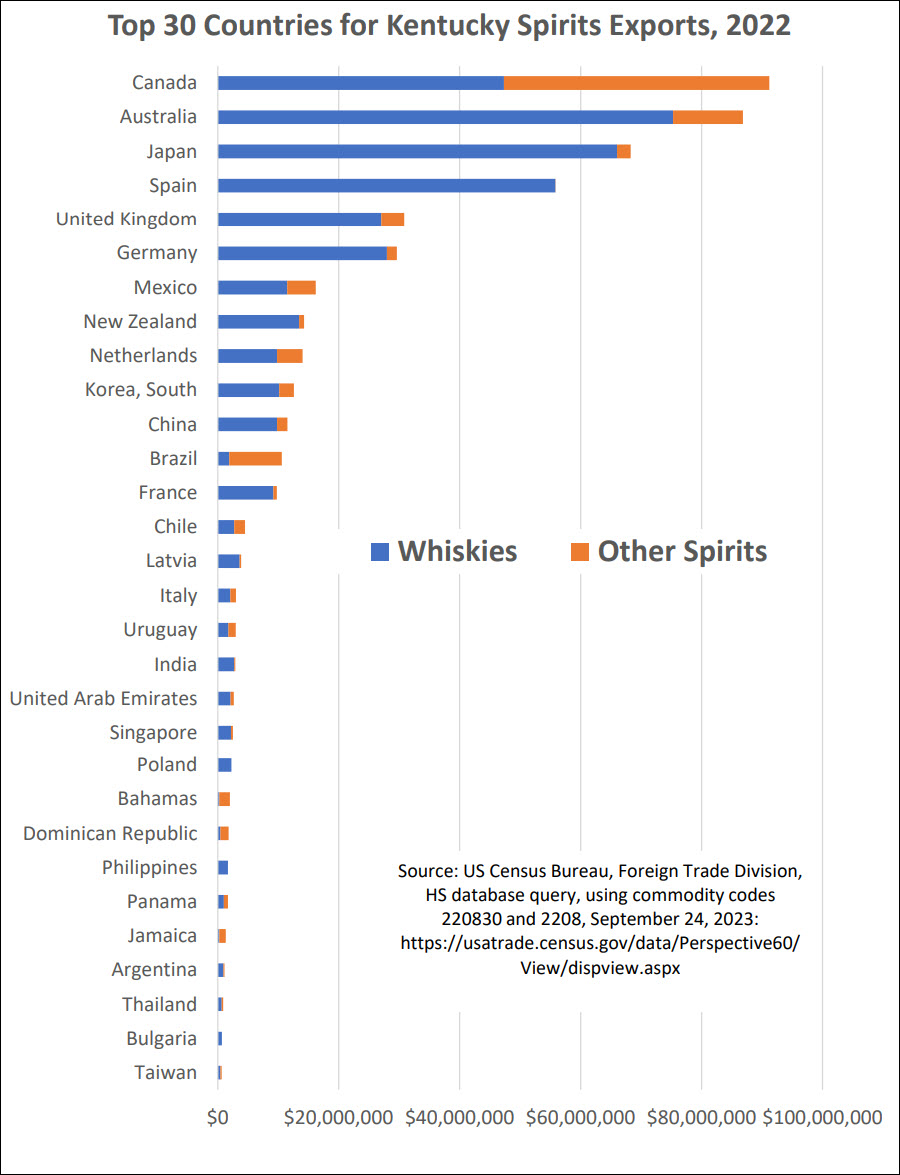
-
Save
How Many People Visited the Kentucky Bourbon Trail in 2023?

-
Save
In 2023 the Kentucky Bourbon Trail and Kentucky Bourbon Trail Craft Tour reported a total of 2.55 million total visits. For clarities sake let’s define how the KDA counts visits. There is no standard across the country on how distilleries counts visits or visitors. Some only count people that are doing a tour, while others include people that skip the tour and do a tasting or they count anyone that walks in the door to buy a bottle.
“You say tomato (toMAYto) I say tomato (toMAHto)” from George Gershwin’s 1937 musical ‘Shall We Dance’ helps to sum it up nicely. What one distillery calls a visitor versesanother may be totally different. The way that Kentucky counts visits versus say a distillery along the Parkway in Gatlinburg, Tennessee (which is a blast to visit) may be totally different. The key is to compare the same numbers at the same location over time.
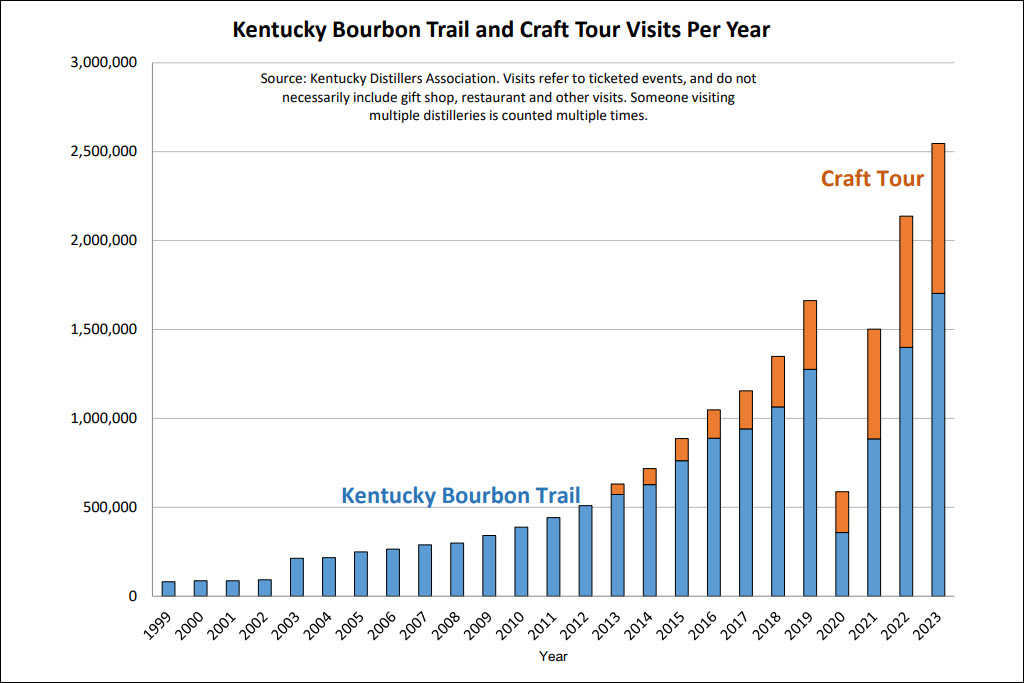
-
Save
The KDA tracks the number of people on the tours. This number includes only people who actually attended a ticketed event at a distillery, not simply those who might stop in a distillery gift shop or restaurant. This measure counts visits, not unique visitors. So, someone visiting two or three distilleries is counted multiple times. Of course, it does not include visitors to non-member distilleries, such as Buffalo Trace in Frankfort, or visitors to KDA member distilleries that do not participate in the two programs. Nevertheless, the history of those visitor counts, shown in the accompanying chart, yields a compelling picture of the growth in Bourbon tourism. One can clearly see the accelerating growth through 2020, the impact of Covid in 2020 (decline of 65%), and the strong bounce back the past three years. Indeed, the annual percentage growth rate was double-digit in sixteen of the past twenty years.
Who is Visiting the Kentucky Bourbon Trail?
The report shares some useful results from a recent survey by IQS Research. IQS conducted detailed intercept surveys at participating distilleries around the state in 2022-2023, recording the place of residence of visitors, demographics, their reasons for visiting and their expenditures by type. They conducted about 3,000 intercept surveys at participating KDA distilleries for 12 months. All visitors surveyed were asked a series of 45 questions, including place of residence, age, household income, the main reason for the trip, length of stay and number in party. Other questions solicited information on such things as gender, race, drinking habits and familiarity with the Kentucky Bourbon Trail® and Kentucky Bourbon Trail Craft Tour® programs. An intercept survey involves a randomized method of approaching someone at a location to elicit information. The intercepts were generally conducted between noon and 4 p.m. across 17 Heritage and 16 Craft members of the KDA.
IQS Research found that respondents came from 48 states, 20 countries and six continents, with 76 percent from outside Kentucky. On average, respondents had visited almost six distilleries in Kentucky in their lifetime. A smaller follow-up e-mail survey indicated that 84 percent stayed in hotels or other rental facilities. IQS found visitors stayed an average of 3.2 days. Visitors had an average annual household income of $130,000. By converting the group spending reported by respondents to individual spending, we found that the average visitor spent $68 per day on lodging (or $137 for two in a room), $46 per day on restaurants and $22 per day on other goods and services. We do not have sufficient information to estimate the in-state transportation expenditures for the nonresident visitors.
A Look Ahead
The large investments planned suggest we will see even more growth in traditional measures of economic activity, such as jobs, payroll and tax payments. Growing at the rate we have observed over the last 14 years, Kentucky’s distilling industry could generate $10 billion in output by 2025, support almost 28,000 jobs, with wages and salaries of $2.16 billion (and projected total labor income of $3.1 billion), and total direct and indirect tax payments to state and local governments of $300 million from production and $152 million from consumption of spirits for a total of $452 million.
The full ‘2024 Bourbon Economic Impact Report’ completed by Dr. Paul Coomes can be found here.
Related Story
Despite Covid, Lockdowns & Tariffs New 74 Page Report Shows Bourbon Pours $9 Billion into Kentucky Economy – Feb 2022
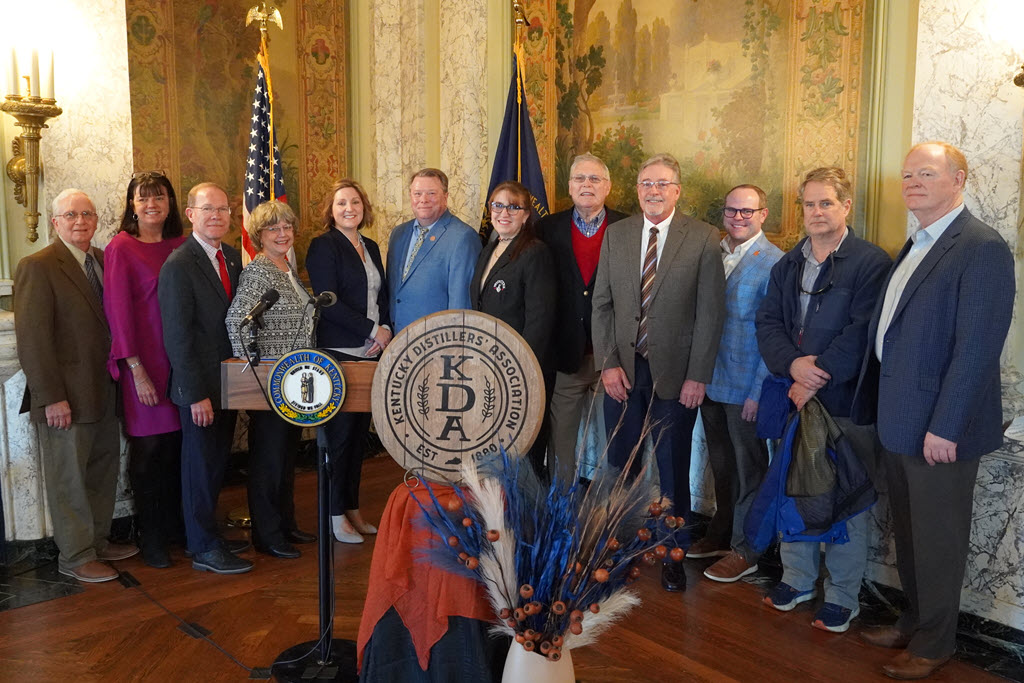
-
Save
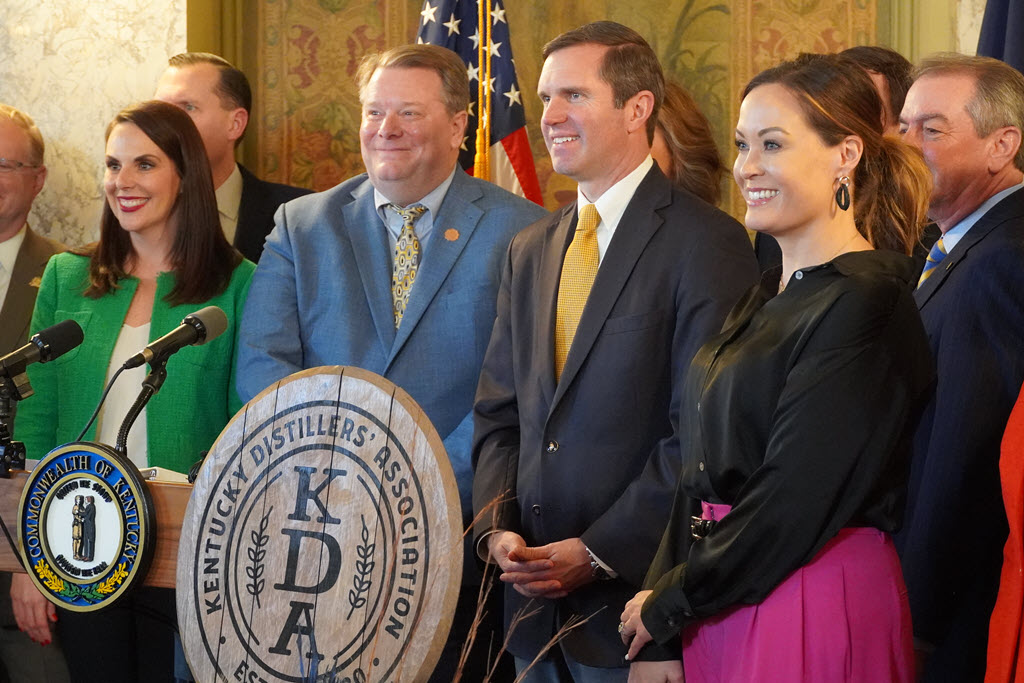
-
Save
Learn more about the Kentucky Distillers’ Association.
View all Kentucky Distilleries.
View all U.S. Distilleries.
Please help to support Distillery Trail. Sign up for our Newsletter, like us on Facebook and follow us on Instagram and Twitter.
———— GET OUR FREE NEWSLETTER ————
————— FEATURED SUPPLIERS —————
View all Featured Suppliers.
———— FEATURED DISTILLERIES ————
View all Featured Distilleries.
———— MOST POPULAR ARTICLES ————
- Texas Files Bill to Make Home Distilling Legal – No…

-
Save
-
- Maker’s Mark 2025 ‘The Keepers Release’ Features the…
![Maker’s Mark 2025 ‘The Keepers Release’ Features the Warehouse Team and 10 Virgin Oak Staves [VIDEO] Maker's Mark Distillery - 2025 Maker's Mark Wood Finishing Series, The Keeper's Release](https://www.distillerytrail.com/wp-content/uploads/2025/03/Makers-Mark-Distillery-2025-Makers-Mark-Wood-Finishing-Series-The-Keepers-Release-Cover-1-300x138.jpg)
-
Save
-
- 2025 Bourbon & Beyond Festival All-star Music…

-
Save
-
- The End of an Era: Brown-Forman Closed its…

-
Save
-
- Woodford Reserve Distillery Releases 2025 Kentucky…

-
Save
-
- Bardstown Bourbon Releases ‘Cathedral French Oak’…

-
Save
-
- Michter’s Distillery 20-Year-Old Bourbon Returns for…

-
Save
-
- Jack Daniel’s Distillery Reports a Partial Whiskey…

-
Save
-
- Woodford Reserve’s 2025 Release of Double Double…

-
Save
-
- Stoli Group and Kentucky Owl Bourbon File for…

-
Save
-
———— DISTILLERY LOCATIONS ————
-
Save
-
Save
-
Save
-
Save
-
Save
-
Save
-
Save
-
Save
-
Save
-
Save
-
Save
-
Save
-
Save
-
Save
-
Save
-
Save
-
Save
-
Save
-
Save
-
Save
-
Save
-
Save
-
Save
-
Save
-
Save
-
Save
-
Save
-
Save
-
Save
-
Save
-
Save
-
Save
-
Save
-
Save
-
Save
-
Save
-
Save
-
Save
-
Save
-
Save
-
Save
-
Save
-
Save
-
Save
-
Save
-
Save
-
Save
-
Save
-
Save
-
Save
-
Save
-
Save
-
Save
-
Save
-
Save
-
Save
-
Save
-
Save
-
Save
-
Save
-
Save
-
Save
-
Save
-
Save
-
Save
-
Save
-
Save
-
Save
-
Save
-
Save
-
Save
-
Save
-
Save
-
Save























